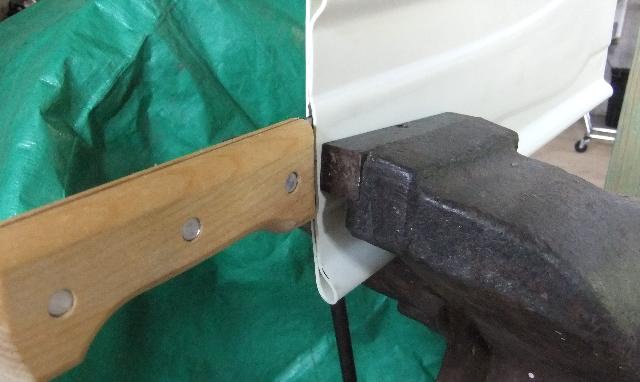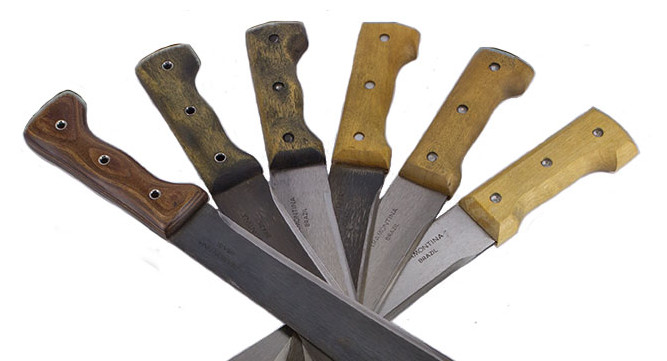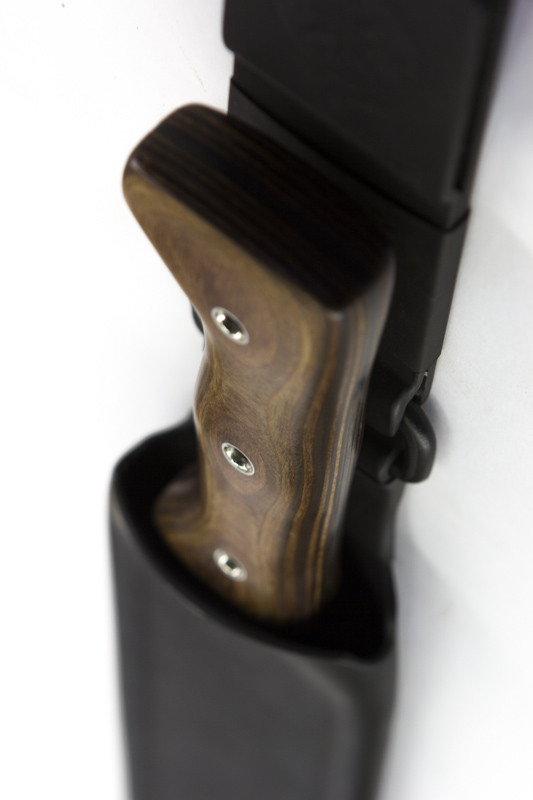How do you reshape the handle?
This article was copied from our FAQs page!
Safety first on this one! It’s easily done by clamping the blade in a vice (like a chainsaw) but never leave a clamped blade in a vice unattended! It’s incredibly dangerous.
We use our postal slip in this situation to improve the safety margin. We stow the machete in this and then clamp it up. It will help protect anything from coming in contact with the edge. Taping the edge up is only good for a visual reminder that something sharp is under there. If you lean up against the tape, the edge will just push through it.

The factory handle is definitely functional as is, however traditional users will spend a considerable amount of time shaping the timber to suit their needs.
The simplest and safest approach is what we call ‘removing the hot spots’. We file down the timber flat until it just hits the spine on the tang. We then blend in all the harsh edges with files and coarse emery cloth strips. Rounding off the holes that sit proud of the rivets helps.
Some like a rough and textured handle for safety, stopping here is an option. Others prefer a smooth handle with a finish on it, there are a few more steps to achieve this.
We continue lightly sanding to remove the scratches from the previous grit and then finish off with some #000 steel wool.
We often apply a finish to help protect and nourish the timber. Danish oil is an old favourite and is commonly used. I have heard of people using Penetrol and swear by it.

Other more natural alternatives like boiled linseed oil are still commonly used on wood handled tools as they dry slowly over a few weeks. We do not use non drying oils. An oily slick handle is dangerous! A finish that breaks down and gets sticky is also not good. We hear about people using common food oils. They never really dry and will eventually soften the timber.
NB! Sweaty hands can be slippery on a handle. The protective finish can impact on safety.
Common things we focus on and are best avoided are:
• Don’t modify the shape of the butt on the handle. It’s the bit that sits behind your pinkie finger and it helps in preventing the handle from slipping out of your hand. Machetes are not a plunging tool, however the swell in front of your thumb and pointer finger help prevent your hand sliding forward onto the edge.
• Removing any material from the handle technically is weakening it. It's a balancing act between safety and function. If you choose to have a shaped handle, don’t take off excessive material and weaken its structure too much. Once it’s gone, you cannot put it back.
• Cracking will happen on any wooden handled tool! Heat, force, humidity and use (including misuse) all speed up the inevitable failure of a wooden handle. Everyone’s environment is different and how they use their tools differs even more. It’s impossible to predict when this will occur, your only safeguard is to constantly maintain and inspect your equipment and you are responsible for that. The Tramontina Eucalyptus hardwood handles are very good quality and will last if you take care of them! So far I have only seen one crack and that was from spending a night in the river.
Here is a link to one of our farm machetes and sheaths that we are using as a longevity test case. The factory Tramontina handle in this link is more than 4 years old, used regularly and has been abused!
Other handle modifications that we are often asked about:
• Busse style tube rivets. They look pretty darn nice on a machete and are incredibly reliable, especially when they are made from thick walled stainless steel tube, coupled with a stabilised handle material.
• Custom handle. These are pretty sought after and we often do these on special requests. They suit users who want a more reliable handle than timber or plastic, or they have very small or large hands. Re handling them is a great DIY project for someone with the know how. A fancy new handle can far exceed the cost of the machete but the platform and results are well worth it! If the base product was not worthy of the effort, we would have told you by now!
• Wood stain under the protective finish.
• High visibility painted butt on the handle helps a lot when you put the machete down. I would keep this small as sweaty hands will slip on paint.

